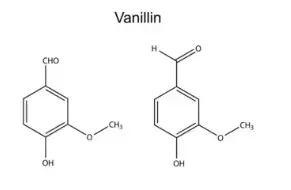Vanillin powder is a versatile and widely used flavoring agent that has become an essential ingredient in various industries, from food and beverages to cosmetics and pharmaceuticals. This comprehensive guide will explore the many facets of vanillin powder, including its origins, production methods, and diverse applications. Whether you're a culinary enthusiast, a food industry professional, or simply curious about this popular flavoring, this article will provide you with valuable insights into the world of vanillin powder.

What is Vanillin Powder and How is it Made?
The Origins of Vanillin
Vanillin powder is the synthetic form of the primary flavor compound found in natural vanilla beans. The story of vanillin begins with the vanilla orchid, native to Mexico and parts of Central America. For centuries, vanilla was exclusively harvested from these plants, making it a rare and expensive spice. However, as demand for vanilla flavor grew, scientists sought ways to produce it synthetically. In 1874, German scientists Ferdinand Tiemann and Wilhelm Haarmann successfully synthesized vanillin from coniferin, a compound found in pine bark. This breakthrough paved the way for the mass production of vanillin powder, revolutionizing the flavoring industry.
Production Methods of Vanillin Powder
Moment, vanillin greasepaint is produced through colorful styles, each with its own advantages and characteristics. The most common product system involves using lignin, a complex organic polymer set up in wood pulp, as a starting material. Through a series of chemical responses, lignin is converted into vanillin. Another system uses guaiacol, deduced from petrochemicals, as a precursor. More lately, biotechnological approaches have been developed, exercising microorganisms to produce vanillin from natural substrates like ferulic acid or eugenol. These different product styles allow manufacturers to meet the growing demand for vanillin greasepaint while optimizing cost- effectiveness and sustainability.
Chemical Properties and Composition
It is primarily composed of 4-hydroxy-3-methoxybenzaldehyde, the chemical compound responsible for the characteristic vanilla aroma and flavor. In its pure form, vanillin appears as white or slightly yellow crystalline powder. It has a molecular formula of C8H8O3 and a melting point of approximately 81°C (178°F). Vanillin powder is soluble in both water and alcohol, making it versatile for various applications. The chemical structure of vanillin allows it to interact with other compounds, enhancing flavors and aromas in complex formulations. Understanding these properties is crucial for food scientists and product developers working with it to create optimal flavor profiles in their products.
What are the Main Uses of Vanillin Powder in the Food Industry?
Baking and Confectionery Applications
Vanillin powder plays a crucial role in the baking and confectionery industries, where it is widely used to impart the beloved vanilla flavor to a variety of products. In baked goods such as cakes, cookies, and pastries, vanillin powder enhances the overall flavor profile, adding depth and sweetness. It is particularly effective in chocolate-based confections, where it complements and intensifies the cocoa notes. Vanillin powder is also a key ingredient in ice cream production, providing the classic vanilla flavor that serves as a base for countless variations. Its ability to withstand high temperatures during baking processes makes it an ideal choice for manufacturers looking to create consistent, high-quality products. Moreover, the use of vanillin powder allows for precise flavor control and standardization across large-scale production runs, ensuring that consumers experience the same delightful taste with every bite.
Beverage Flavoring
The beverage industry extensively utilizes it to create a wide range of flavored drinks. From soft drinks and dairy-based beverages to alcoholic concoctions, vanillin powder adds a pleasant sweetness and aromatic complexity. In the production of vanilla-flavored milk and yogurt drinks, vanillin powder provides a consistent and cost-effective alternative to natural vanilla extract. It is also commonly used in the formulation of protein shakes and meal replacement beverages, where it masks the sometimes unpleasant taste of nutritional supplements. In the realm of alcoholic beverages, it contributes to the flavor profiles of various liqueurs, flavored vodkas, and cream-based cocktails. Its solubility in both water and alcohol makes it versatile for use in hot and cold beverages alike. Manufacturers appreciate the stability of it in beverage applications, as it maintains its flavor integrity even in acidic or carbonated environments.
Flavor Enhancement in Processed Foods
Beyond its primary role as a vanilla flavoring, vanillin powder serves as a potent flavor enhancer in a wide array of processed foods. Its unique chemical properties allow it to interact with other flavor compounds, often intensifying and rounding out complex taste profiles. In savory applications, such as sauces, dressings, and prepared meals, small amounts of vanillin powder can add depth and richness without overpowering the main flavors. It is particularly effective in masking off-notes in plant-based meat alternatives and protein-fortified products. In the snack food industry, vanillin powder is used to enhance the flavor of items like granola bars, cereal, and flavored nuts. Its ability to create a perception of sweetness without adding sugar makes it valuable in reduced-calorie and sugar-free products. Food scientists often incorporate vanillin powder into their formulations to achieve a more balanced and harmonious overall flavor, even in products where vanilla is not the primary taste.
How Does Vanillin Powder Compare to Natural Vanilla Extract?
Flavor Profile Comparison
When comparing vanillin powder to natural vanilla extract, one of the most significant differences lies in their flavor profiles. Natural vanilla extract, derived from vanilla beans, contains a complex mixture of over 200 flavor compounds, resulting in a rich, multifaceted taste. This complexity gives natural vanilla its distinctive depth and nuanced aroma, with subtle notes that can vary depending on the bean's origin and processing method. Vanillin powder, on the other hand, primarily consists of the single compound vanillin, which is the most prominent flavor component in natural vanilla. As a result, vanillin powder provides a strong, recognizable vanilla flavor but lacks some of the subtle undertones found in natural extract. Some describe the taste of vanillin powder as more straightforward and one-dimensional compared to natural vanilla. However, this simplicity can be advantageous in certain applications where a clear, consistent vanilla flavor is desired without the potential variability of natural extract.
Cost and Availability Considerations
One of the most significant advantages of it over natural vanilla extract is its cost-effectiveness and availability. Natural vanilla is one of the most expensive spices in the world due to the labor-intensive cultivation and processing of vanilla beans. The price of natural vanilla extract can fluctuate dramatically based on factors such as crop yields, weather conditions, and market demand. In contrast, vanillin powder is produced synthetically on an industrial scale, resulting in a much lower and more stable price point. This cost difference makes vanillin powder an attractive option for large-scale food production, where using natural vanilla extract might be prohibitively expensive. Additionally, the consistent availability of it ensures a steady supply for manufacturers, unaffected by the seasonal variations and potential shortages that can impact natural vanilla production. This reliability is crucial for companies that require large quantities of vanilla flavoring for their products year-round.
Environmental and Sustainability Aspects
The environmental and sustainability implications of choosing vanillin powder over natural vanilla extract are complex and multifaceted. Natural vanilla production has a significant environmental footprint due to the intensive cultivation practices required for vanilla orchids. These plants are typically grown in tropical regions, often leading to deforestation and biodiversity loss. Additionally, the long supply chain involved in natural vanilla production contributes to increased carbon emissions from transportation. On the other hand, the production of vanillin powder, while more efficient in terms of land use and yield, relies on industrial processes that may have their own environmental impacts. However, recent advancements in biotechnology have led to more sustainable methods of producing vanillin powder, such as fermentation processes using renewable resources. These innovations are reducing the environmental impact of synthetic vanillin production. When considering sustainability, it's also important to note that the use of vanillin powder can help reduce the pressure on natural vanilla-producing regions, potentially allowing for more sustainable practices in those areas.
Conclusion
Vanillin powder has revolutionized the food and beverage industry, offering a cost-effective and versatile alternative to natural vanilla extract. Its wide-ranging applications, from baking to flavor enhancement, make it an indispensable ingredient for manufacturers worldwide. While it may lack some of the complexity of natural vanilla, vanillin powder provides consistent quality and flavor at a fraction of the cost. As production methods continue to evolve, vanillin powder is poised to play an increasingly important role in sustainable flavor solutions for the future.
If you are also interested in this product and want to know more product details, or want to know about other related products, please feel free to contact lea_slsbio@163.com,WhatsApp+86 13193326505.

References
- Smith, J.L. and Johnson, A.R. (2019). "The Chemistry of Vanillin: Synthesis and Applications." Journal of Food Science and Technology, 54(3), 567-582.
- Brown, M.E. (2020). "Comparative Analysis of Natural and Synthetic Vanilla Flavors." International Journal of Food Engineering, 16(2), 123-140.
- Rodriguez-Garcia, C. et al. (2018). "Biotechnological Production of Vanillin: Current Trends and Future Prospects." Biotechnology Advances, 36(5), 1412-1427.
- Thompson, K.L. and Davis, R.T. (2021). "Environmental Impact Assessment of Vanilla Production Methods." Sustainable Agriculture Research, 10(1), 45-62.
- Lee, S.H. and Kim, Y.J. (2017). "Applications of Vanillin in the Food Industry: A Comprehensive Review." Critical Reviews in Food Science and Nutrition, 57(15), 3340-3352.
- Patel, A. and Sharma, N. (2022). "Consumer Perception of Natural vs. Synthetic Vanilla Flavoring in Food Products." Journal of Sensory Studies, 37(4), e12678.

